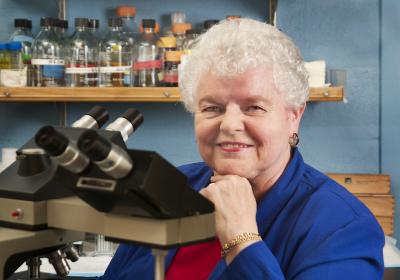May 6, 2004
Development of the retina:Anita Hendrickson to present Distinguished Scientist Lecture
Until Dr. Anita Hendrickson began her research in the late 1960s, scientists had largely ignored the development of the human retina, in particular the fovea, the area that gives us our high visual acuity.
Hendrickson, professor of biological structure and of ophthalmology, will give the Science in Medicine Distinguished Scientist Lecture on Thursday, May 20, at noon in Hogness Auditorium at the Health Sciences Center. Her talk, iopen to everyone, is titled “Here’s Looking at You: The Development of the Human Retina.”
The fovea is a specialized area of the retinas of humans, monkeys and great apes. In the fovea, the inner layers of the retina are moved laterally to make a pit. Within that pit are cones, the photoreceptors that give us the highest visual acuity and color vision. Although cones are everywhere in the retina, they are at the highest concentration in the foveal center.
“Our best vision depends on around 10,000 cones tightly packed into the foveal center,” Hendrickson said.
Hendrickson used as an experimental model the Old World monkey, because macaques have a visual system almost identical to the human.
“We knew little at the time about the development of the primate retina,” she said. In 1976, Hendrickson published the first paper on development of the fovea since a German monograph 62 years earlier. She has gone on to identify the basic mechanisms that form this complex structure.
Hendrickson’s pioneering work has helped others in their study of adult macular degeneration, a retinal disease in which foveal function is lost.
“If you lose the fovea, you can’t read, watch TV or drive—it’s a devastating thing,” she said.
Her early work also included a breakthrough technique in tracing neuron anatomy, meaning that scientists could reliably trace pathways in the brains of all species.
“There was an explosion of neuroanatomy studies following that, revealing so much about brain connections that we never realized,” Hendrickson said.
Hendrickson continued doing a number of retina and central nervous system studies on the primate visual system, while at the same time building an administrative career that would see her become chair of Department of Biological Structure in 1994, breaking a number of “glass ceilings” along the way.
She was the first female professor in the Department of Ophthalmology, the first female basic sciences chair and the first woman on numerous UW and national councils and committees. She received her bachelor’s degree from Pacific Lutheran University in Tacoma and her Ph.D in biological structure from the UW in 1964.
“There weren’t many of us women when I started here, but we were very close,” Hendrickson said. “It could be very lonely, and you had to be twice as good as the average man to be accepted. And you could never let anyone see you cry.”
Hendrickson credited a number of mentors, in particular Drs. Carl Kupfer and Bob Kalina, former chairs of the Ophthalmology Department, for helping her get started in the 1970s.
“But in a way it might have been easier for women back then. Not as much was expected of us,” she said. “The expectations are so high for women today. They are expected to have a world-class career and raise a family without breaking a sweat.”
Hendrickson and her husband Morrie, the retired head of the drama department at Shoreline Community College, have raised three children — twin daughters Lisa and Karin and son Gordon.
“I’ve thoroughly enjoyed my life and work here at the University,” she said. “The Primate Center has been a unique resource that has been essential for my research.”
At 68, Hendrickson is looking forward to retirement, but she has a bit more work to do first, she says.
Her research is now focusing on the New World monkey, the marmoset.
The marmoset has the same sequence of foveal development as the macaque, but is born with a quite immature fovea that allows experimental work to be done to alter development. Hendrickson and her lab team are investigating the causes of myopia, which has become a major public health problem in Asia, where up to 90 percent of youngsters have this eye problem. Myopia in youngsters can lead to macular degeneration in later life.
“We are using a combination of experimental myopia, modeling and anatomy to identify the mechanical forces that create a normal fovea and to see how too much eye growth changes foveal development,” she said. “I’m hoping to finish this exciting finding with the marmoset. If we can come up with some kind of answer, I will be extremely happy to retire.”
But Hendrickson wonders who will continue her work in the future.
“There are only a handful of retinal anatomists working in the field today, and almost none in primates,” she said. “It may not be as long as 62 years before another paper is published on this subject, but I feel that this information is going to have to be the database for the next 10 years at least.”



